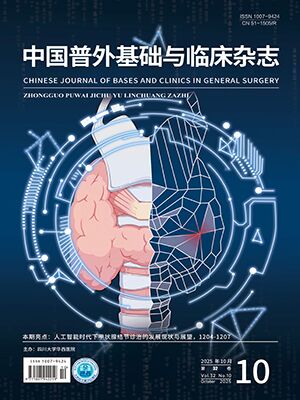| 1. |
王少明, 郑荣寿, 韩冰峰, 等. 2022年中国人群恶性肿瘤发病与死亡年龄特征分析. 中国肿瘤, 2024, 33(3): 165-174.
|
| 2. |
田文, 石臣磊, 万政. 我国甲状腺癌外科治疗近10年进展. 中国实用外科杂志, 2022, 42(8): 841-844.
|
| 3. |
Tessler FN, Middleton WD, Grant EG, et al. ACR thyroid imaging, reporting and data system (TI-RADS) : white paper of the ACR TI-RADS committee. J Am Coll Radiol, 2017, 14(5): 587-595.
|
| 4. |
万政, 王冰, 惠庆磊, 等. 人工智能技术联合甲状腺超声影像和数据系统 (TI-RADS) 分级对甲状腺结节良恶性诊断价值的研究. 中华内分泌外科杂志, 2022, 16(2): 185-189.
|
| 5. |
王冰, 张明博, 万政, 等. 动态人工智能超声辅助诊断系统对甲状腺结节诊断价值研究. 中国实用外科杂志, 2022, 42(6): 680-684.
|
| 6. |
刘志艳, 刘东戈. 我国甲状腺结节细胞病理近十年的回顾与展望. 中华病理学杂志, 2025, 54(6): 575-579.
|
| 7. |
Hu G, Niu W, Ge J, et al. Identification of thyroid cancer biomarkers using WGCNA and machine learning. Eur J Med Res, 2025, 30(1): 244. doi: 10.1186/s40001-025-02466-x.
|
| 8. |
花苏榕, 王智弘, 李佳颐, 等. 深度学习技术识别喉返神经在经胸乳入路腔镜甲状腺手术中的探索. 中华内分泌外科杂志, 2022, 16(3): 287-292.
|
| 9. |
花苏榕, 王智弘, 高俊义, 等. 深度学习技术识别喉返神经在经腋窝腔镜甲状腺手术中的探索. 中华内分泌外科杂志, 2022, 16(1): 5-11.
|
| 10. |
田文, 陈志达, 郗洪庆, 等. 近红外自体荧光显像技术在甲状腺癌根治性手术中辅助甲状旁腺识别应用1例报告并文献复习. 中国实用外科杂志, 2020, 40(5): 591-593.
|
| 11. |
Avci SN, Isiktas G, Berber E. A visual deep learning model to localize parathyroid-specific autofluorescence on near-infrared imaging: localization of parathyroid autofluorescence with deep learning. Ann Surg Oncol, 2022. doi: 10.1245/s10434-022-11632-y.
|
| 12. |
Wang B, Zheng J, Yu JF, et al. Development of artificial intelligence for parathyroid recognition during endoscopic thyroid surgery. Laryngoscope, 2022, 132(12): 2516-2523.
|
| 13. |
Yao S, Shen P, Dai F, et al. Thyroid cancer central lymph node metastasis risk stratification based on homogeneous positioning deep learning. Research (Wash D C), 2024, 7: 0432. doi: 10.34133/research.0432.
|
| 14. |
田文, 姚京, 王冰, 等. 5G远程手术机器人辅助甲状腺癌根治术初步研究. 中国实用外科杂志, 2024, 44(9): 1075-1077, 1080.
|
| 15. |
Lee D, Kong HJ, Kim D, et al. Preliminary study on application of augmented reality visualization in robotic thyroid surgery. Ann Surg Treat Res, 2018, 95(6): 297-302.
|
| 16. |
Lee JH, Lee CY, Eom JS, et al. Predictions for three-month postoperative vocal recovery after thyroid surgery from spectrograms with deep neural network. Sensors (Basel), 2022, 22(17): 6387. doi: 10.3390/s22176387.
|
| 17. |
Seib CD, Roose JP, Hubbard AE, et al. Ensemble machine learning for the prediction of patient-level outcomes following thyroidectomy. Am J Surg, 2021, 222(2): 347-353.
|
| 18. |
Yang CQ, Gardiner L, Wang H, et al. Creating prognostic systems for well-differentiated thyroid cancer using machine learning. Front Endocrinol (Lausanne), 2019, 10: 288. doi: 10.3389/fendo.2019.00288.
|
| 19. |
Mao Y, Huang Y, Xu L, et al. Surgical methods and social factors are associated with long-term survival in follicular thyroid carcinoma: construction and validation of a prognostic model based on machine learning algorithms. Front Oncol, 2022, 12: 816427. doi: 10.3389/fonc.2022.816427.
|
| 20. |
Kim SY, Kim YI, Kim HJ, et al. New approach of prediction of recurrence in thyroid cancer patients using machine learning. Medicine (Baltimore), 2021, 100(42): e27493. doi: 10.1097/MD.0000000000027493.
|
| 21. |
Park YM, Lee BJ. Machine learning-based prediction model using clinico-pathologic factors for papillary thyroid carcinoma recurrence. Sci Rep, 2021, 11(1): 4948. doi: 10.1038/s41598-021-84504-2.
|
| 22. |
Gruson D, Dabla P, Stankovic S, et al. Artificial intelligence and thyroid disease management: considerations for thyroid function tests. Biochem Med (Zagreb), 2022, 32(2): 020601. doi: 10.11613/BM.2022.020601.
|
| 23. |
Zeng H, Zheng R, Guo Y, et al. Cancer survival in China, 2003-2005: a population-based study. Int J Cancer, 2015, 136(8): 1921-1930.
|
| 24. |
Zeng H, Zheng R, Sun K, et al. Cancer survival statistics in China 2019-2021: a multicenter, population-based study. J Natl Cancer Cent, 2024, 4(3): 203-213.
|




